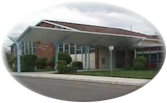Challenging Choices: Immersion in One School or Multiple Sites?
The ACIE Newsletter, February 2005, Vol. 8, No. 2
by María Roldán, 3rd Grade Teacher
and Spanish Immersion Curriculum Assistant, Memorial Elementary,
Upton, MA
Dan Leclerc, Director of Curriculum, Mendon-Upton Regional
School District, Mendon, MA
 |
Miscoe Hill Elementary |
The Mendon–Upton Regional School District launched the Spanish Immersion Program (SIP) in the fall of 1998, with a single kindergarten class of 26 students and one teacher. Today the program includes a total of thirteen classrooms with twelve bilingual/bicultural teachers from Spanish-speaking countries around the world and the U.S. Approximately 12 percent of the district’s students—310 out of 2,575—are currently enrolled in SIP.
As a total immersion program, the district’s K-2 curriculum
is taught completely
 |
Memorial Elementary |
in Spanish beginning the first day of school. English Language Arts instruction begins in the third grade for a portion of the school day, with class time devoted to English increasing in subsequent grades.
For the first six years of its existence the immersion program
was housed solely at Miscoe Hill Elementary School in Mendon.
The 2004-05 opening of Mendon-Upton Regional Schools’
two new elementary sites prompted district-level decision
makers to distribute the program across three sites—two
K-3 schools and one 4-7 school, all within a six mile radius.
As a result, the SIP is
 |
Henry P. Clough Elementary |
now available and accessible to families throughout the district. Memorial Elementary School in Upton and Henry P. Clough Elementary school in Mendon each have a K-3 strand of immersion classrooms. Miscoe Hill Elementary School continues its program with two 4th-, one 5th- and one 6th-grade Spanish immersion classroom, and plans to add a second 5th grade and a new 7th grade classroom next fall. The district is committed to continuing the SIP into high school with classes specifically designed to challenge the immersion students.
Benefits and Challenges
The multiple location approach brings with it both benefits
and challenges. For parents and teachers alike, the transition
from one school site to three has created some logistical
complications. Due to the distance between schools, planning
and scheduling district-wide SIP events for all parents has
proven difficult and can be a source of frustration. Furthermore,
rehearsals for program-wide performances involving students
are only possible if students are transported to a single
location. As a consequence, International Night is now the
only event where all three schools participate. The decision
to reduce the number of all-school activities to one event
eliminates multiple scheduling conflicts; through International
Night, however, the SIP is still represented as a whole. Also,
since International Night is an evening event, the district
is not responsible for bussing, which eases transportation
complexities.
Another logistical challenge is the organization of Parent
Nights. Orientation for new incoming Spanish immersion kindergartners,
for example, now needs to be held at both Memorial and Henry
P. Clough Elementary schools. This situation requires additional
planning, materials, and presentation time for the SIP staff.
The biggest challenge of the multiple location model is that
Spanish immersion teachers and their students cannot work
together as efficiently on different activities. Being in
one building gave SIP staff the flexibility to communicate
frequently with colleagues and administrators, and to bring
students together for interaction with same grade-level peers.
Now, with the school split, sharing materials occurs less
often, and collaborative planning becomes difficult and lacks
spontaneity. Inorder to accomplish a particular task, such
as producing a program newsletter, teachers from different
locations must find a common time to meet and travel to one
site either before or after the normal work day. It is difficult
to preserve the desired frequency of communication due to
the distance between schools and the difference in schedules.
At times teachers have felt as if they have three disparate
programs within the same program.
Benefits Outweigh the Challenges
The multiple location model also introduces a number of benefits.
Importantly, the district does not separate the Spanish Immersion
Program from the non-immersion elementary program by design.
Rather, the students in the SIP mix regularly in activities
commonly scheduled by the schools. Students go to recess and
lunch by grade level, and Art, Music, Media, Physical Education
and Technology classes are consistent within a grade level,
regardless of whether the students attend the SIP or an English-speaking
classroom. Because of this intermingling, the perception of
immersion as an elitist program is less likely to develop
and all students are able to participate in the rich specialist
programming offered at their grade level.
Whether this program continues with the current multiple school
approach or opts to move again towards a program within one
school, the success of the program resides in the enthusiasm
and support shown by parents, administrators, and staff. From
the early days of the program, the active participation of
all of these stakeholders has been, and continues to be, a
decisive factor in assuring its improvement and growth. This
is a dynamic process based on ideas, discussions, and a critical
auto-evaluation which, combined with commitment and support,
guarantee the Spanish Immersion Program's permanent evolution.